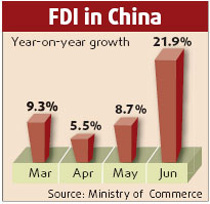The latest statistics from the State Electricity Regulatory Commission (SERC) show domestic electric power production has seen a continued rapid increase of 1.47 trillion kilowatt-hours (kwh) in the first half of the year, up 15.9 percent from 2006.
Meanwhile, the domestic installed capacity has surpassed 650 million kw, holding the second position worldwide together with generated energy for the tenth consecutive year.
However, there are five weak spots that may hinder the industry's further development if they are not paid due attention. "Neither the quantity nor quality of the domestic electric power industry could meet the needs," said You Quan, chairman of the SERC.
First on the list is the low level of installed capacity per capita. Compared with the beginning of the Reform and Opening-up period, domestic installed capacity and electric power production have increased almost tenfold. However, the per capita amount is merely 0.5 kw, 0.3 kw in some regions, which is only 10 percent of that in developed countries. Additionally, residents in some remote areas do not have electricity at all.
Secondly, investment on grid construction is insufficient. According to SERC figures, although the State Grid Corporation invested 176 billion yuan (US$23.3 billion) on network construction in 2006, the grid investment was only 30 percent of the whole power industry, 20 percent less than that in developed countries. Furthermore, construction on electric transmission and distribution is far behind power supply.
The third concern is regional electricity shortages. Although the domestic installed capacity is second in the world, the balance between supply and demand is fragile because of strains in some regions like south China, Guangdong Province in particular.
Fourth is the environmentally unfriendly structure of the electric power industry. Thermal power has accounted for 78 percent of total generated energy while recycling and nuclear power occupy a small part. This leads to high-consumption of energy and large quantities of pollution.
Lastly, SERC is worried about over-consumption of electricity in industries with heavy pollution. According to figures released by the National Bureau of Statistics, the energy consumption of GDP per 10,000 yuan (US$1,321.69) declined by 1.33 percent in 2006 while electricity consumption of GDP per 10,000 yuan increased by 2.75 percent. In the first half of this year, the added value of industries above a designated size has increased by 18.5 percent. Among them, six energy-intensive industries (which consume 70 percent of industrial energy) have increased 20.1 percent, 3.6 percent up over 2006.
"The over-consumption and rapid increase of energy-intensive industries and those with heavy pollution are not in accord with the policy of energy saving and pollution reduction, and not good for the improvement of the electric power industry," You explained.
(China.org.cn by Li Shen July 26, 2007)

